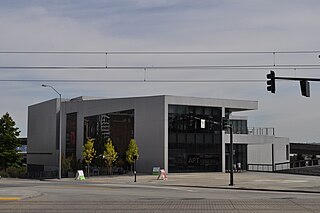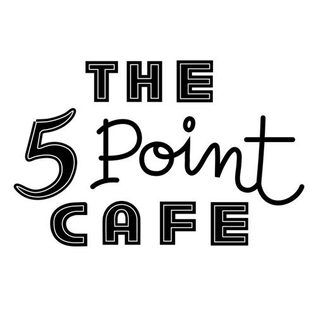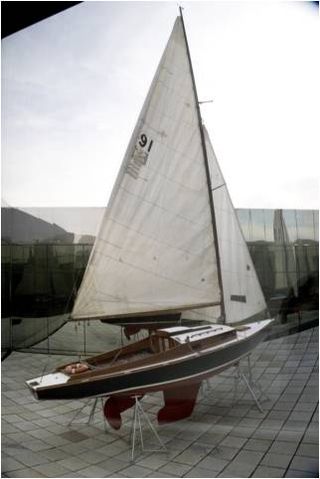Related Research Articles

The Frye Art Museum is a modern and contemporary art museum in the First Hill neighborhood of Seattle, Washington. It was founded in 1952 to house the collection of Charles and Emma Frye and has since grown to include rotating temporary exhibitions of emerging and contemporary artists.

The Henry Art Gallery is a contemporary art museum located on the campus of the University of Washington, in Seattle, Washington, United States. Located on the west edge of the university's campus along 15th Avenue N.E. in the University District, it was founded in February, 1927, and was the first public art museum in the state of Washington. The original building was designed by Bebb and Gould. It was expanded in 1997 to 40,000 square feet (3,700 m2), at which time the 154-seat auditorium was added. The addition/expansion was designed by Gwathmey Siegel & Associates Architects.

Consolidated Works was a "multi-disciplinary contemporary arts center" located successively in two former warehouses in the South Lake Union neighborhood of Seattle, Washington, USA, just west of what would be considered the Cascade neighborhood within South Lake Union. It incorporated an art gallery, theater, cinema, and music/dance/lecture hall, as well as studio spaces for artists and a bar and lounge.

Washington Park is a public park in Seattle, Washington, United States, most of which is taken up by the Washington Park Arboretum, a joint project of the University of Washington, the Seattle Parks and Recreation, and the nonprofit Arboretum Foundation. Washington Park also includes a playfield and the Seattle Japanese Garden in its southwest corner. To the north is Union Bay; to the west are Montlake and Madison Valley; to the south is the Washington Park neighborhood; and to the east is the Broadmoor Golf Club.
Hammering Man is a series of monumental kinetic sculptures by Jonathan Borofsky. The two-dimensional painted steel sculptures were designed at different scales, were painted black, and depict a man with a motorized arm and hammer movement to symbolize workers throughout the world. They were structurally engineered by Leslie E. Robertson Associates (LERA).

Morris Cole Graves was an American painter. He was one of the earliest Modern artists from the Pacific Northwest to achieve national and international acclaim. His style, referred to by some reviewers as Mysticism, used the muted tones of the Northwest environment, Asian aesthetics and philosophy, and a personal iconography of birds, flowers, chalices, and other images to explore the nature of consciousness.

The Tacoma Art Museum (TAM) is an art museum in Tacoma, Washington, United States. It focuses primarily on the art and artists from the Pacific Northwest and broader western region of the U.S. Founded in 1935, the museum has strong roots in the community and anchors the university and museum district in downtown Tacoma.

Westlake Center is a four-story shopping center and 25-story office tower in downtown Seattle, Washington, United States. The southern terminus of the Seattle Center Monorail, it is located across Pine Street from Westlake Park, between 4th and 5th Avenues. It is named for Westlake Avenue, which now terminates north of the mall but once ran two blocks farther south to Pike Street. Westlake Park is considered Seattle's "town square" and celebrities and political figures often make appearances or give speeches from the building's balcony. The anchor stores are Saks Off 5th and Nordstrom Rack.

The McLeod Residence was an art cooperative and gallery based in the Belltown area of Seattle, Washington. It closed in October 2008.
Gary Faigin is an American artist, author, co-founder and Artistic Director of the Gage Academy of Art, Seattle.

The 5 Point Cafe is a bar and 24-hour cafe in the Belltown neighborhood of Seattle, Washington, owned by Dave Meinert. It is located by Tilikum Place and is open since 1929. It is considered the oldest drinking establishment in the neighborhood and has received accolades from local media for being one of the best dive bars in the city.

Stone Wave occupies the central courtyard of Tacoma, Washington's Tacoma Art Museum and is a major public work by sculptor Richard Rhodes of Seattle, Washington. Completed in May, 2003, the wave is constructed using 650 unique pieces of antique Chinese granite laid on a substrate of closed-cell foam and mortar. At once echoing the surging of waves and the volcanic core of Mount Rainier, the sculpture presents a zone of visual serenity among the museum's galleries.
Platform Gallery was a contemporary art gallery formerly located in the Tashiro Kaplan Building in historic Pioneer Square District in Downtown Seattle. It was founded in 2003 by four artists, including Stephen Lyons, who in 2008 was sole owner. In late 2016, the gallery moved from its brick and mortar space to exhibiting and selling artworks exclusively online. In art critic Regina Hackett's 2005 Seattle Post-Intelligencer article on Pioneer Square, she credits the gallery with contributing to the neighborhood's "core of cultural tolerance and open-minded experiment". The gallery attracted attention for exhibitions of works on paper as well as contemporary photography and sculpture.

The Pollinator Pathway is a participatory art, design and ecology social sculpture initiative founded by the artist and designer Sarah Bergmann. Its objective is to connect existing isolated green spaces and create a more hospitable urban environment for pollinators like bees with a system of ecological corridors of flowering plants by using existing urban infrastructure such as curb space and rooftops.

Café Allegro is a coffeeshop in the University District of Seattle, Washington, United States. It is notable for being one of the city's first espresso shops and for its role in the history of Starbucks, as the place where founding proprietor Dave Olsen designed the Starbucks coffee product line. Situated in an alleyway, the cafe features multiple entrances and rooms.
The and/or alternative space was an exhibition, project, and performance space founded by Anne Focke in Seattle, Washington. The first alternative art exhibition and performance space in the Pacific Northwest, and/or was located at 1523 Tenth Avenue in Capitol Hill, and included an art library, a video editing and viewing facility, and an electronic music facility.
The Foster/White Gallery is an art gallery in Seattle, Washington, in the United States. It was started as the Richard White Gallery in 1968 in the Pioneer Square neighborhood.

The Wildrose is a lesbian bar in Seattle, Washington. It is located in the Capitol Hill neighborhood, and opened in 1985. It is the city's only lesbian bar. Business partners Shelley Brothers and Martha Manning, the current owners of The Wildrose, took over from the original founders in the early 2000s.

Tariqa Waters is a multifaceted contemporary artist known for her whimsical larger-than-life fabrications, painting, self-portraiture and installations. Waters works in varied media, including canvas, wood, plastic, ceramics, paint, glass, and photography. Waters’ work has been featured in numerous institutions and galleries including the Seattle Art Museum, Frye Art Museum, Hedreen Gallery, and Pivot Art + Culture. Waters’ work has been featured in issues of Rolling Stone France and Madame Figaro magazines.

Amir Zaki is an American artist based in Southern California. He is best known for "hybridized" photographs using digital and analog technologies that explore the rhetoric of authenticity, vocabulary of documentary, and acts of looking and constructing images. His work often focuses on the iconography and landscape of Southern California, simultaneously celebrating the banal and vernacular and subverting its related mythology. Zaki has exhibited nationally and internationally, and been featured in shows at the Whitney Museum of American Art, Orange County Museum of Art, California Museum of Photography, and San Jose Museum of Art. His work is held in the public collections of the Los Angeles County Museum of Art, Hammer Museum, New Museum, and Whitney Museum, among many, and appears in the anthologies Vitamin Ph (2006), Photography is Magic and Both Sides of Sunset: Photographing Los Angeles (2015).
References
- ↑ Apello, Tim. "Howard's Not in the House" Archived 2010-12-26 at the Wayback Machine . City Arts Magazine. August 1, 2010.
- ↑ Graves, Jen. "Howard House Is Closing". The Stranger. May 28, 2010.